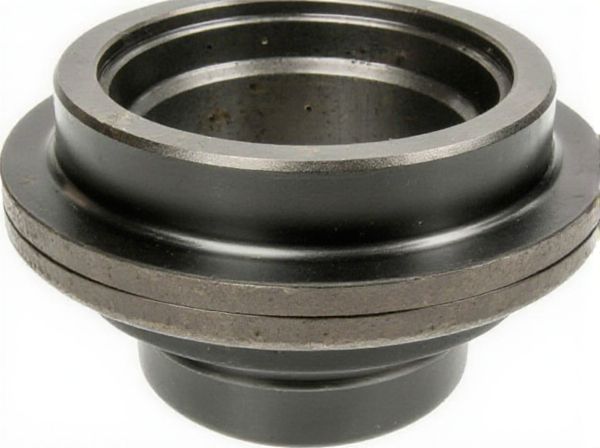
Photo illustration: Slip-yoke vs Fixed-yoke
Slip-yoke allows for axial movement and flexibility in the driveshaft, accommodating changes in length due to suspension travel or drivetrain angles. Fixed-yoke provides a rigid connection that enhances durability and strength but requires precise alignment to avoid driveline vibrations. Choosing between slip-yoke and fixed-yoke depends on your vehicle's suspension setup and performance needs.
Table of Comparison
| Feature | Slip-Yoke Transmission | Fixed-Yoke Transmission |
|---|---|---|
| Design | Allows driveshaft length adjustment through sliding slip-yoke | Uses fixed yoke with slip joint in driveshaft for length changes |
| Drive Shaft Movement | Absorbs suspension movement by sliding yoke | Compensates via driveshaft slip joint |
| Maintenance | Easier to inspect and replace slip-yoke components | Requires more driveshaft disassembly for repairs |
| Durability | May wear out faster due to sliding motion | Generally more robust and long-lasting |
| Common Use | Popular in light-duty trucks and older vehicles | Preferred in heavy-duty and modern performance vehicles |
| Installation | Simpler and quicker to install | More complex due to fixed connection |
Introduction to Slip-Yoke and Fixed-Yoke
Slip-yokes allow axial movement of the driveshaft by sliding in and out of the yoke, accommodating changes in length as the suspension moves. Fixed-yokes, in contrast, are solidly attached without any sliding capability, providing a more rigid and stable connection but requiring other components to manage driveline length variations. The slip-yoke's design reduces stress on the drivetrain during suspension travel, while the fixed-yoke setup often relies on slip splines or other flexible joints to absorb movement.
Overview of Driveshaft Yoke Types
Slip-yoke driveshafts offer flexibility by allowing axial movement to accommodate suspension travel and changing driveline angles, reducing stress on drivetrain components. Fixed-yoke driveshafts maintain a constant length and rely on CV joints or slip joints elsewhere to manage driveline articulation, providing improved strength and stability for high-torque applications. Understanding the specific vehicle requirements and driving conditions is crucial when selecting between slip-yoke and fixed-yoke driveshaft designs.
What is a Slip-Yoke?
A slip-yoke is a type of driveshaft component designed to slide in and out of the transmission or transfer case, allowing changes in driveline length caused by suspension movement or engine torque variations. It consists of a splined shaft that fits into a corresponding yoke, providing flexibility and preventing damage to the driveline during flexing or twisting. Slip-yokes are commonly used in rear-wheel-drive vehicles and off-road applications for improved driveline durability and smoother power transmission.
What is a Fixed-Yoke?
A fixed-yoke is a type of driveshaft yoke that is rigidly attached to the driveshaft, providing a solid connection between the transmission or transfer case and the driveshaft. Unlike a slip-yoke, which allows for length adjustment to accommodate suspension movement, a fixed-yoke requires a slip joint elsewhere in the driveline to handle changes in shaft length. Fixed-yokes offer enhanced durability and reduced risk of slipping or disconnection, making them common in heavy-duty and off-road driveline applications.
Key Differences Between Slip-Yoke and Fixed-Yoke
Slip-yokes allow axial movement along the driveshaft, enabling accommodation of suspension travel and driveline length changes, whereas fixed-yokes are rigidly mounted, providing a more stable and vibration-resistant connection. Slip-yoke designs aid in flexibility but can cause wear in the transmission seal over time, while fixed-yokes typically require a separate slip joint for length adjustment, reducing seal wear and enhancing durability. Understanding these differences is crucial for selecting the appropriate yoke type based on vehicle application and drivetrain performance requirements.
Advantages of Slip-Yoke Systems
Slip-yoke systems offer significant advantages in drivetrain flexibility by allowing axial movement, which accommodates changes in driveshaft length due to suspension travel or load shifts. This design reduces stress on the transmission and other drivetrain components, enhancing durability and overall vehicle performance. Furthermore, slip-yokes facilitate easier maintenance and smoother power transfer, making them ideal for off-road and heavy-duty applications.
Benefits of Fixed-Yoke Designs
Fixed-yoke designs offer enhanced durability and reduced maintenance compared to slip-yokes due to their rigid construction, which minimizes wear from movement and reduces the risk of contamination. They provide better torque transfer efficiency by maintaining constant alignment between the transmission and driveshaft components. Fixed-yokes also improve drivetrain stability and reduce vibrations, resulting in smoother vehicle operation and extended component lifespan.
Common Applications for Each Yoke Type
Slip-yoke driveshafts commonly appear in rear-wheel-drive trucks and off-road vehicles, allowing axial movement to accommodate suspension travel and drivetrain articulation. Fixed-yoke driveshafts are typically used in performance and racing applications, where precise alignment and reduced driveline vibration are crucial for high-speed stability. Industrial machinery and agricultural equipment often utilize fixed-yoke designs for their durability and ability to handle consistent torque loads without the risk of yoke slip.
Performance and Maintenance Considerations
Slip-yoke driveshafts offer enhanced flexibility by allowing axial movement, reducing stress on the drivetrain during suspension travel and preventing binding, which improves overall performance in off-road and high-mobility vehicles. Fixed-yoke driveshafts provide a more rigid connection, resulting in less drivetrain play and higher torque capacity, which benefits performance in heavy-duty and high-power applications. Maintenance for slip-yoke systems requires regular lubrication of the slip joint to prevent wear and corrosion, while fixed-yoke systems demand precise alignment and periodic inspection to avoid vibration issues and premature bearing failure.
Choosing the Right Yoke for Your Vehicle
Choosing the right yoke for your vehicle hinges on drivetrain compatibility and vehicle application, with slip-yokes offering smooth axial movement for drivetrains experiencing length changes, while fixed-yokes provide a rigid connection beneficial for stable driveshaft alignment. Slip-yokes minimize vibration and wear in off-road or modified suspensions where axle articulation varies, whereas fixed-yokes enhance strength and durability in heavy-duty or high-torque scenarios. Understanding your vehicle's suspension type, load demands, and intended use ensures the optimal yoke selection, balancing performance with longevity.
 caratoz.com
caratoz.com